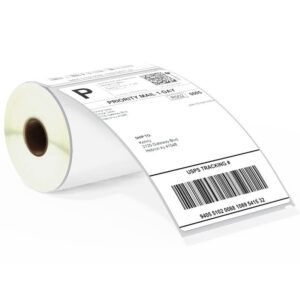How to Choose the Right Dymo Label for Your Needs?
Choosing the right Dymo label for your needs is essential to ensure that your labeling tasks are efficient and effective. Dymo offers a wide range of labels, each designed for specific applications, including home organization, office labeling, industrial uses, and more. This comprehensive guide will help you understand the different types of Dymo labels available, their specific features, and how to select the best one for your particular requirements. Additionally, we will address common questions to further assist you in making an informed decision.Dymo 1744907
Understanding Dymo Label Types
Dymo labels come in various types, each suited for different purposes. Here are the main categories:
1. Paper Labels
Paper labels are the most common and versatile type of Dymo labels. They are ideal for everyday labeling tasks, such as organizing files, labeling envelopes, and creating name tags. Paper labels are typically used indoors and are available in various sizes and colors.
2. Plastic Labels
Plastic labels are more durable than paper labels and are resistant to water, oil, and chemicals. These labels are suitable for labeling items that may be exposed to moisture or harsh conditions, such as kitchen containers, bathroom products, and outdoor equipment. They are also available in a variety of sizes and colors.
3. Metallic Labels
Metallic labels are designed for high-visibility labeling tasks. They have a shiny, metallic finish that makes them stand out, making them perfect for labeling electronics, tools, and other items where visibility is crucial. These labels are durable and resistant to wear and tear.
4. Vinyl Labels
Vinyl labels are highly durable and flexible, making them ideal for industrial and outdoor applications. They are resistant to UV light, moisture, chemicals, and extreme temperatures. Vinyl labels are perfect for labeling pipes, machinery, and safety equipment.
5. Heat Shrink Tubes
Heat shrink tubes are designed for labeling cables and wires. These labels shrink when heated, providing a secure and permanent label that conforms to the shape of the wire or cable. They are commonly used in electrical and telecommunications applications.
6. Removable Labels
Removable labels are designed to be easily removed without leaving residue. They are ideal for temporary labeling tasks, such as price tags, promotional labels, and temporary instructions. These labels are useful in retail environments and for short-term projects.
Choosing the Right Dymo Label
To choose the right Dymo label for your needs, consider the following factors:
1. Application
Determine the specific application for your labels. Are they for home organization, office use, industrial settings, or outdoor environments? Understanding the purpose of the labels will help narrow down your options.dymo 30252
2. Durability
Consider the durability requirements for your labels. If the labels will be exposed to moisture, chemicals, or extreme temperatures, choose a durable material like vinyl or plastic. For indoor use where durability is less of a concern, paper labels may suffice.
3. Adhesive Strength
Different labels have varying adhesive strengths. For labels that need to stick securely to rough or uneven surfaces, choose labels with a strong adhesive. For temporary labeling, opt for removable labels that can be easily peeled off.
4. Visibility
Consider the visibility needs for your labels. For high-visibility applications, such as safety warnings or important instructions, metallic or brightly colored labels are ideal. For standard labeling tasks, white or clear labels may be sufficient.Dymo 30256
5. Size and Shape
Choose the appropriate size and shape for your labels based on the items you are labeling. Dymo labels come in various widths and lengths, so select a size that fits well on the surfaces you are labeling.
6. Compatibility
Ensure that the labels you choose are compatible with your Dymo label printer. Check the printer’s specifications to find out which label types and sizes it supports.
Practical Tips for Using Dymo Labels
Test Labels First: Before applying a large number of labels, test a few to ensure they adhere well and are readable in the intended environment.
Store Labels Properly: Store unused labels in a cool, dry place to maintain their adhesive properties and prevent damage.
Clean Surfaces Before Labeling: Ensure that the surfaces you are labeling are clean and dry to ensure the labels stick properly.
Use Label Software: Utilize Dymo’s label software to design and print labels efficiently. The software offers various templates and customization options.
Choosing the right Dymo label involves understanding the different types available and considering factors such as application, durability, adhesive strength, visibility, size, and compatibility. By carefully evaluating your needs and following the practical tips provided, you can select the most suitable Dymo label for your specific requirements. This will ensure that your labeling tasks are efficient, effective, and long-lasting.
FAQs
Q1: Can I use Dymo labels for outdoor applications?
Yes, certain Dymo labels, such as vinyl and plastic labels, are designed for outdoor use. They are resistant to UV light, moisture, and extreme temperatures, making them suitable for outdoor labeling tasks.
Q2: How do I know if a label is compatible with my Dymo printer?
Check the specifications of your Dymo label printer to find out which label types and sizes it supports. Dymo’s website and user manuals provide detailed compatibility information for each printer model.Dymo 30336 labels
Q3: Are Dymo labels easy to remove without leaving residue?
Dymo offers removable labels specifically designed to be easily removed without leaving residue. These labels are ideal for temporary labeling tasks and can be peeled off cleanly.
Q4: What should I do if my labels are not sticking properly?
If your labels are not sticking properly, ensure that the surfaces you are labeling are clean and dry. Using labels with a stronger adhesive may also help. Additionally, make sure you are using the correct type of label for the surface and environment.



